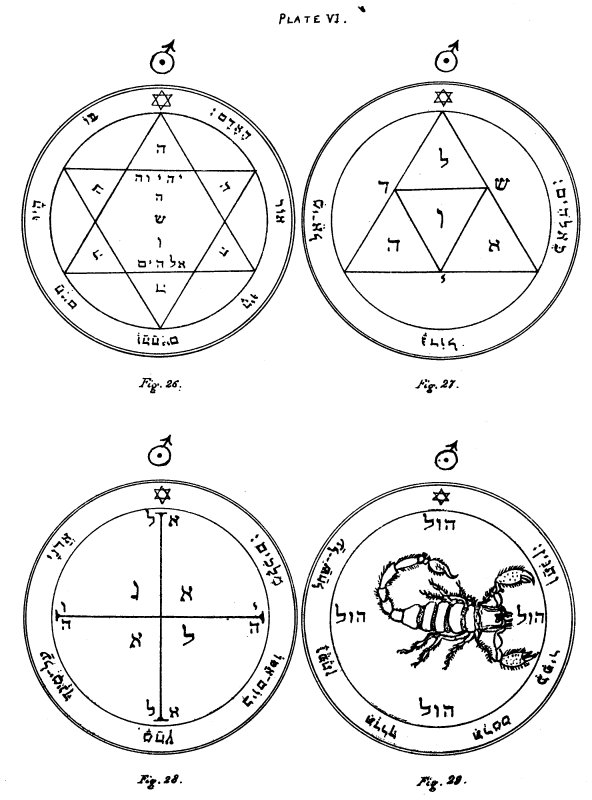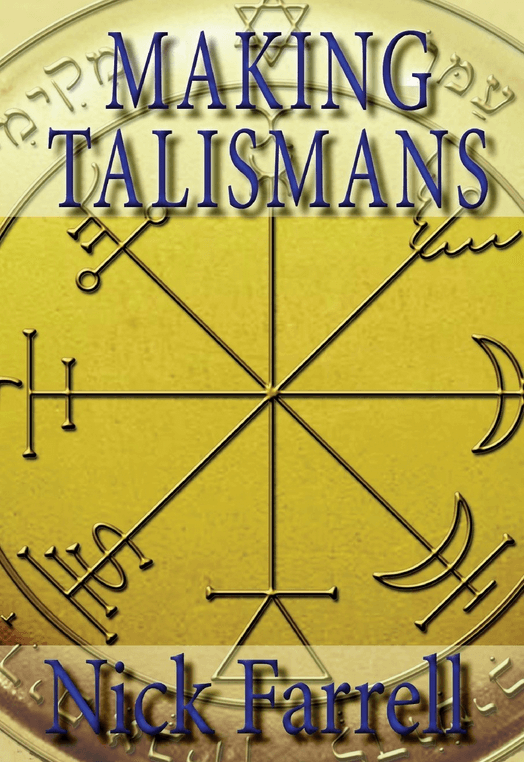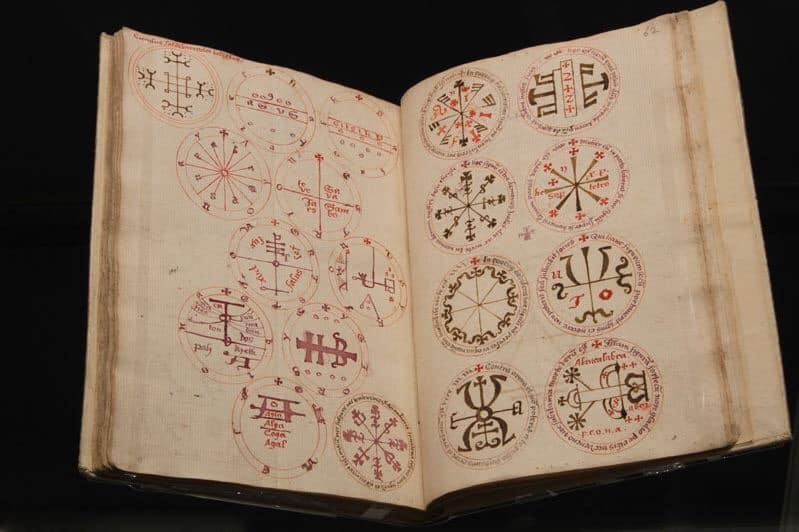This post is to answer a debate held on Aaron Leitch’s Facebook group. My central premise is that using Key of Solomon pentacles as talismans is incorrect and that pentacles have apparent, practical magical differences from Talismans.
 Pentacles are mentioned in the Key of Solomon. Cast versions used to be sold cheaply in occult book shops, and I picked up a few when I was in New Zealand for $10 each. Cut versions typically using laser etching printers can be found on Etsy, with some costing $450 each. They are primarily marketed as Talismans, which are carried around by the user to bring wealth, protection, etc. This is not new. They have been marketed this way for a long time and might have been a feature of hoodoo or European folk magic. In many ways, it makes sense. With their geometric shapes, Hebrew letters, and sometimes images, Pentacles look like Talismans (see left).
Pentacles are mentioned in the Key of Solomon. Cast versions used to be sold cheaply in occult book shops, and I picked up a few when I was in New Zealand for $10 each. Cut versions typically using laser etching printers can be found on Etsy, with some costing $450 each. They are primarily marketed as Talismans, which are carried around by the user to bring wealth, protection, etc. This is not new. They have been marketed this way for a long time and might have been a feature of hoodoo or European folk magic. In many ways, it makes sense. With their geometric shapes, Hebrew letters, and sometimes images, Pentacles look like Talismans (see left).
However, the Key of Solomon, particularly in its early drafts, tends to play down the use of pentacles as talismans. For example, in The Clavicle of Solomon, revealed by Ptolomy the Grecian. [Sloane manuscript 3847 edited by Joseph H. Peterson], which is the earliest dated April 8, 1572 makes no mention of pentacles being used as talismans. It says they are consecrated by having three masses said over them to control spirits during a Key of Solomon ritual and provide physical protection during the ritual.
“In this Clauicle or Canderiarum consisteth all the Science of this Clauicle, for there, all the science beginneth and therfore in the operation of this booke the Clauicle [Clavicle] doth take his effect, and he that will be perfect in this craft, let him begin soe as it is declared of the pentacle and of the same pentacles be certayne exorcizmes and names ineffable and carecters and signes of all the science, therefore, in them the whole science of all this art lyeth hydd the pentacles or canderie be [24r] uncertayne with most glorious and holyest names they were written in the tables of Moyses and Salomon by deuine reuelation had them and gathered them together, and consecrated them to all necessity of mans body, and for there safegard.”
The Key describes the pentacles being made on Wednesday when the moon is on the ascendant of an air or earth sign (Air signs: Gemini, Libra, Aquarius; Earth signs: Taurus, Virgo, Capricorn.) The way I read it, the sun should be in the air sign and the moon in one of the other signs. The Pentacles should be made of paper and coloured (presumably in some planetary ink). They should be started to be drawn in the correct planetary hour. The should be placed in a silk bag and consecrated over an incense burner of ligno mastico masculo & ligno aloe and then say three masses over it for three days.
“Say this 3 dayes continuall upon the foresayed pentacles and cause three masses to be sayed of ye Holy Ghost, and one of Our Lady, and afterward put the foresaid signes, in a silke cloth with goodly sauours, and put them up in a cleane place. And when it is neede, ye may worke as it is said of the artes magicall, of thy cloth were decked with gold it were of more efficacye, and when they be put in a cleane place, fumigate them and sprincle them with water and Isope [hyssop] and soe let them alone. They haue immumerable vertues as it is contained heareafter.”
To what purpose? The Clavicle of Solomon, revealed by Ptolomy the Grecian, says that a pentacle enables a person to conjure a spirit, and it will obey him. If the spirit appears before the magician, it will have no objection to what you want. Furthermore, the spirit will provide a long list of benefits. However, in this early version of the Key, there is no mention of them being worn after from the ritual or claims that they are talismans. This idea appears to have been inserted into some texts later.
So what is the problem?
 Magically a talisman’s definition is specific. “It is a physical body for magical energy focused on a specific intention.” It has symbols and divine names connected to the spirit, but its function is to anchor the spell in earth for a longer-term effect. They are living entities.
Magically a talisman’s definition is specific. “It is a physical body for magical energy focused on a specific intention.” It has symbols and divine names connected to the spirit, but its function is to anchor the spell in earth for a longer-term effect. They are living entities.
In 2001, I explained in my first book Making Talismans , that a Talisman is closer to the Cabbalistic concept of a Golem – an artificial entity ensouled by the force of a ritual to bring about an intention. However, a pentacle has a more general goal of making a connection to a spirit. It is a communication device to speed dial and control a spirit, much like a magical tool. Sure, you could carry it away from the ritual say if you needed that spirit’s protection, but the result is not Talismanic.
The method for making a talisman is elaborate and far above a simple consecration or purification (or even saying Mass over it several times). That is enough for a magical weapon but not enough for a talisman. Being a living creature, a Talisman must have four levels. It must have a divine spark, an spiritual direction and an astral body which is attached to the physical body. The body of a talisman is designed with the correct symbols and made at the right times to assist the alignment with the planetary forces. They then have a ritual in which the magical power (planetary, astrological, etc) are linked to the physical object.
Such rituals pre-date the Key of Solomon by several thousand years and can be seen in the Ancient Egyptian ritual of the Opening of the Mouth. It is possible to see the effect of such rituals by visiting these statues in a museum and feel the power coming off them thousands of years later.
The modern method of Making Talismans mostly has its roots in Agrippa, where these four levels are clearly mapped out, and yet. At the same time, Agrippa was aware of the Key of Solomon approach, his Talismanic lore does not create anything that looks like a pentacle.
Looking at more modern approaches, the Golden Dawn method of consecrating a talisman mimicked its own Neophyte initiation in which the “dead” candidate is bought to life. While you might not want to charge a talisman using this method (it is a little clunky), it clearly shows the process involved.
The physical talisman (which has been made at the correct time) is bought in, purified and consecrated (four times for each “level”), made to conform to its purpose, the spirit which ensouls it is summoned, and finally fused with the talisman.
This makes a good comparison between the pentacle creation. A pentacle will be purified (ie made acceptable to the divine) and consecrated (ie set aside by an intention) but the other components of ensouling are missing. The reciting of mass over the pentacle three times is an attempt to redeem the matter it is made, rather than an actual ensouling. In any event, it is not going to tune the matter to planetary force without an invocation. Nor is there any attempt to link the pentacle to a specific intention or divine force. There is enough here to make a good ritual tool but not a talisman.
Another issue is that the talisman is not expected to control the spirits involved in its creation. They are just working through it to obtain the ritual’s intention.
Pentacles in the Key of Solomon are made of paper while a talisman might be constructed from an appropriate metal. True, in his translation, Sam Mathers does refer to them as “medals” which implies metal. However, this is because Mathers feels obliged to translate the word candarii which might have been talismans involved in Solomonic practice which dropped from the main tradition. They are not described and there were either four, nine, or 12 of them depending on your source. While candarii have been found, and some people are using them, they were never part of the main tradition which has lived mainly without them. At this point, none of the “talismans” on the market are candarii.
So why do they work?
The strongest arguments for using Key of Solomon pentacles for talismans are “that they work” and their use is a feature of folk magic, Hoodoo and Folk Magic. Yet evidence for the claim appears limited to chanting “it always works” and “other people do it too,” which are useless for an experimental magician.
Confirming magical results always have problems with people either attributing a likely event to the results of a talisman they created or a placebo effect. A person who tells a healing talisman’s creator that they feel better and yet loses a body part to the illness a few months later is not an example of a talisman that worked. Neither is a talisman that preserves the status quo is also unlikely ever to prove its validity. If you are worried that you will lose your job and you buy a talisman and keep it, how can you be sure that this was the result of magic and that you were never going to lose it in the first place? It sounds factious but if you made a talisman to make the sun come up every morning, would you consider that making a successful talisman that “always works.”
There needs to be a more careful analysis of magical results and a few more statistics and the proof does not have to come from the side making talismans traditionally. It must come from those who see pentacles as talismans because they are swimming against the current of established magical practice.
Another elephant in the room is the problem of superstition and fraud. Magic, with its close connections with traditions, sometimes includes things which “look good” or are just superstitions which meaning if it ever had a reason, has been long forgotten. For example, flogging a hoodoo bag with a Key of Solomon pentacle with other ingredients may look and feel good but magically is meaningless. Even if these were consecrated, the Key of Solomon has no rules for passing on such material to a customer.
Then there is the problem that we have to accept metal Key of Solomon pentacles for magical practice because suppliers make more money (and they are easier to make) by laser etching them, and they look more like talismans, even if the original tradition says draw them.
Practical differences
Using a pentacle to obtain a specific love
Draw the fifth pentacle of Venus in Green ink on a virgin sheet of paper. Purify and consecrate the paper and take it with you to mass three times (or do the full mass ritual over it yourself). Use the pentacle to invoke the spirit of Venus while holding the pentacle in your left hand. After the ritual is complete take the pentacle with you on your date and while holding it in your left hand ask the spirit to intervene so that the object of your affections might want you… you could add My heart is like wax it is melted in the midst of my bowels. (Psalm 22 vrs 14)
Using a Talisman to obtain a specific love
On a Friday in the hour of Venus make a talisman from copper (or green paper) perhaps in the shape of a seven-pointed star. Purify and consecrate it then invoke Elohim El Gibel, or YHVH Tsbaoth and ask it to use the talisman to make your date with the love of your life work. Then invoke Aniel, then Hagiel and finally the spirit Kedemel and ask them to work through the talisman to make your date with the love of your life work. Charge the talisman by whatever means you know (if only there were a good book out there with some rituals to do that 🙂 ). Take the talisman on your date and forget it is in your pocket.
In short
Key of Solomon pentacles are different creatures from talismans and are designed to control spirits in a Key of Solomon ritual. Done correctly, they are drawn on paper on Wednesday, are part of the magician’s relationship with the Angel or spirit and cannot be outsourced.
If modern-day talisman makers want to flog their material, they should focus on creatively making new authentic talismans rather than jumping on a poorly researched myth.

Comments are closed